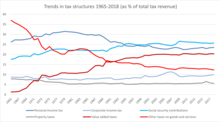
Back ضريبة غير مباشرة Arabic Impuestu indireutu AST Dolayı vergi Azerbaijani Ситләтелгән һалым Bashkir Косвен данък Bulgarian Indirektni porez BS Impost indirecte Catalan Nepřímá daň Czech Indirekte skat Danish Nerekta imposto Esperanto
| Part of a series on |
| Taxation |
|---|
 |
| An aspect of fiscal policy |
An indirect tax (such as sales tax, per unit tax, value-added tax (VAT), or goods and services tax (GST), excise, consumption tax, tariff) is a tax that is levied upon goods and services before they reach the customer who ultimately pays the indirect tax as a part of market price of the good or service purchased. Alternatively, if the entity who pays taxes to the tax collecting authority does not suffer a corresponding reduction in income, i.e., impact and tax incidence are not on the same entity meaning that tax can be shifted or passed on, then the tax is indirect.[1]
An indirect tax is collected by an intermediary (such as a retail store) from the person (such as the consumer) who pays the tax included in the price of a purchased good. The intermediary later files a tax return and forwards the tax proceeds to government with the return. In this sense, the term indirect tax is contrasted with a direct tax, which is collected directly by government from the persons (legal or natural) on whom it is imposed. Some commentators have argued that "a direct tax is one that cannot be charged by the taxpayer to someone else, whereas an indirect tax can be."[2]


Indirect taxes constitute a significant proportion of total tax revenue raised by the government. Data published by OECD show that the average indirect tax share of total tax revenue for all member countries in 2018 was 32.7% with standard deviation 7.9%. The member country with the highest share was Chile with 53.2% and at the other end was USA with 17.6%.[5] The general trend in direct vs indirect tax ratio in total tax revenue over past decades in developed countries shows an increase in direct tax share of total tax revenue. Although this trend is also observed in developing countries, the trend is less pronounced there than in developed countries.[6]
Indirect taxes have several uses, the most prominent one (same as for direct taxes) is to raise government revenue. Sales tax and value-added tax (VAT) play the major role in this, with VAT being more commonly used around the world. The distinction between these two taxes is that sales tax is paid by the customer at the moment of purchase of the final good or service, whereas VAT is a multistage tax imposed on goods and services that is collected in parts at each stage of production and distribution of goods and services in proportion to the value added by each taxpaying entity.[1]
Apart from the role in raising government revenue, indirect taxes, in the form of tariffs and import duties, are also used to regulate quantity of imports and exports flowing in and out of the country. In case of imports, by tariff imposition the government protects domestic producers from foreign producers that may have lower production costs, and thus are able to sell their goods and services at lower prices, driving domestic producers out of the market. After tariff imposition, imported goods become more expensive for domestic consumers, hence domestic producers are better-off than before tariff imposition.
Furthermore, indirect taxes in the form of excise taxes are used to reduce the consumption of goods and services that create negative externalities. For instance, an excise tax imposed on a pack of cigarettes increases the price of cigarettes, which leads to decreased consumption of cigarettes, which leads to the reduction of health conditions caused by smoking and second-hand smoking. Moreover, the tax discourages the youth from taking up smoking as they have quite elastic price elasticity of cigarette demand.[7]
The concept of Value-Added Tax (VAT) as an indirect tax was the brainchild of a German industrialist, Dr. Wilhelm von Siemens in 1918. A hundred years later, the tax which was devised to be efficient and relatively simple to collect and enforce is, together with Goods and Services Tax (GST), now in place in over 140 countries globally.[8]

- ^ a b Schenk, Alan; Oldman, Oliver (2007). "Chapter 1: Survey of Taxes on Consumption and Income, and Introduction to Value Added Tax". Value Added Tax: A Comparative Approach (1st ed.). Cambridge University Press. pp. 5, 23. ISBN 978-0-521-85112-1.
- ^ Britannica Online, Article on Taxation Archived 2008-06-10 at the Wayback Machine. See also Financial Dictionary Online, Article on Direct taxes Archived 2008-08-21 at the Wayback Machine.
- ^ OECD (2020), Revenue Statistics 2020, Chapter 1: Tax revenue trends 1965-2018. Organisation for Economic Co-operation and Development. https://doi.org/10.1787/888934209457
- ^ OECD (2020), Revenue Statistics 2020. Chapter 1: Tax revenue trends 1965-2018. Organisation for Economic Co-operation and Development. https://doi.org/10.1787/888934209457
- ^ OECD (2020), Revenue Statistics 2020, Chapter 1: Tax revenue trends 1965 - 2019, Table 1.1, Last update 26-Nov-2020. Organisation for Economic Co-operation and Development. https://www.oecd-ilibrary.org/sites/213bafbd-en/index.html?itemId=/content/component/213bafbd-en#tablegrp-d1e314 Archived 2022-01-14 at the Wayback Machine
- ^ Martinez-Vazquez, Jorge; Vulovic, Violeta; Liu, Yongzheng (2010). "Direct versus Indirect Taxation: Trends, Theory and Economic Significance". International Center for Public Policy Working Paper Series. International Center for Public Policy, Andrew Young School of Policy Studies, Georgia State University.
- ^ Sharbaugh, Michael S.; Althouse, Andrew D.; Thoma, Floyd W.; Lee, Joon S.; Figueredo, Vincent M.; Mulukutla, Suresh R. (2018-09-20). "Impact of cigarette taxes on smoking prevalence from 2001-2015: A report using the Behavioral and Risk Factor Surveillance Survey (BRFSS)". PLOS ONE. 13 (9): e0204416. Bibcode:2018PLoSO..1304416S. doi:10.1371/journal.pone.0204416. ISSN 1932-6203. PMC 6147505. PMID 30235354.
- ^ "International Indirect tax guide, Article on grantthornton.global". Archived from the original on 2020-09-19. Retrieved 2018-11-19.
© MMXXIII Rich X Search. We shall prevail. All rights reserved. Rich X Search